Where should I put my money?

A lot of people look at investing as a complex process, driven by overwhelming amounts of data and a level of unpredictability that makes survival only possible for those with iron hearts and expendable incomes. At least that’s the feeling that’s been beaten into investors for far too many years. But as Benjamin Franklin famously said, “An investment in knowledge pays the best interest.” That means blocking out what you hear, focusing instead on what you know, or in this case, need to know.
The truth is, investing does not have to be intimidating. I have always believed that the process itself is artificially made to appear complex and daunting to justify finance companies’ high fees. Investing is simply a decision of where to put your money when you’re not using it.
The reality is that you have to put your hard-earned money somewhere, whether you stuff it under the mattress or invest through either an active or passive approach. Depending on your levels of optimism, income and trust, there are several places to turn, and in this blog post, I’ll take a look at three separate areas where people often place their finances.
From traditional banks with savings accounts to brokerage firms that allow you to make all the moves yourself, you need to find the choice that gives you a feeling of security while also providing a chance to succeed. Here’s a look at the pros and cons of these three traditional investing options:
Banks
As the oldest financial institutions in the country, banks have been providing services to willing customers for more than 200 years. A majority of Americans use checking and savings accounts as their only option for their money. It’s true that these options are ultra-safe and provide easy access to funds. Yet the ease and simplicity comes with a hefty and hidden downside: you earn almost nothing. The average savings account interest is 0.06% per year, a full 2% points below current inflation. That means, in real buying power terms, you effectively pay 2% every year for this privilege of quick and easy access. The cost simply doesn’t show up on your statement.
Now the bank actually earns plenty on your money, earnings that you could easily capture with minimal effort. This reminds me of something Robert G. Allen once said:
“How many millionaires do you know who have become wealthy by investing in savings accounts?”
Banks are a default option. They are easy but come with a sizeable hidden downside. While they’re safe in the short-term, they’re actually risky in the long-run because you’ll be unlikely to meet your financial goals.
Advisors
The advisor landscape is vast and well-known thanks in part to an endless stream of advertising. Familiar names such as Morgan Stanley and Edward Jones litter the landscape and do their best to create an aura or mystery about the investing process – while touting the credentials and predictive ability of their experts as being your best solution. And, if you have a relatively significant number of holdings, you’re even treated to a few perks on occasion.
However, the advisor option is laden with high fees. It’s a unique industry where the customer pays for poor results, as a majority fail to beat the broad-based indices. Further, you actually don’t have much control over your money once you hand it over to them, access is fairly limited, and you often don’t know what you’re invested in. (Was there something fun in any of that?)
DIY Brokerage
For the well-heeled investor who has the time and resources to handle every aspect of their investment, the DIY brokerage firm is the way they often go. Names like Charles Schwab, TD Ameritrade and E*TRADE provide the highest level of control, and if you have a large sum of money it can be very cost-effective (always a $5-10 fee whether it’s a $250 or $250,000 transaction). These brokerages also offer more esoteric financial products like options and futures, as there are higher margins for such investments.
The downside to the DIY brokerage is twofold: not everyone wants or likes this level of control and despite the control, and the commission structure is limiting for most account sizes. There’s a significant difference between wanting to participate in your investment choices and making it a part-time day job implementing said choices.
The DIY brokerages typically cater to the latter, and if you want to make any changes, in my opinion and experience, the interfaces are usually quite clunky, unintuitive and intimidating.
Even with commissions recently falling at some brokerages, it becomes really expensive with any amount of diversification. A portfolio with 20 positions could incur $200 in commissions if you want to add, subtract or rebalance each position, which also must be done in whole shares. This makes it especially difficult for young investors who want to incrementally build up a portfolio over time.
Finding a More Desirable Option
With all of these choices offering varying degrees of ease, control and fees, where is the middle ground? Where is the sweet spot that delivers the simplicity of a savings account, the intelligence of an advisor, and the choice of a brokerage firm? The personal investment space has been badly in need of modernization and innovation, an option that blends the beauty of those previously mentioned investing strategies but incorporating a fresh approach that resonates with all ages, from Millennials to the Boomer generation.
M1
I feel the best of all these worlds is M1 Finance, a company I launched to reinvigorate a stagnant financial services industry. M1 is a wealth management partner out to change the world’s ability to manage their money. M1 is simple, convenient and as easy to use as any savings account—but meant to deliver a substantially higher financial payoff over time by putting your money constantly to work.
Allowing you as much control as you want, M1 is what we like to call “engaged investing.” It maximizes the strengths of each current investing option while minimizing the weaknesses.
M1 is built and designed to be a complete money management platform. We are a completely free investing platform, eliminating fees and commissions so your money can work harder for you. We automate buying and selling for you so the time required to manage your money is minimized. However, you have full control over where your money is invested. After all, it is your money. You can participate in your portfolio construction to the extent you feel comfortable, using expertly designed portfolio “Pies,” designing it all yourself, or any combination in between.
M1 is intended to ensure your best and most efficient financial experience. Tour the M1 website and see for yourself, and if you have questions or comments, we’d love to hear from you.
Sincerely,

Brian Barnes
Founder & CEO, M1 Finance
- Categories
- Plan



